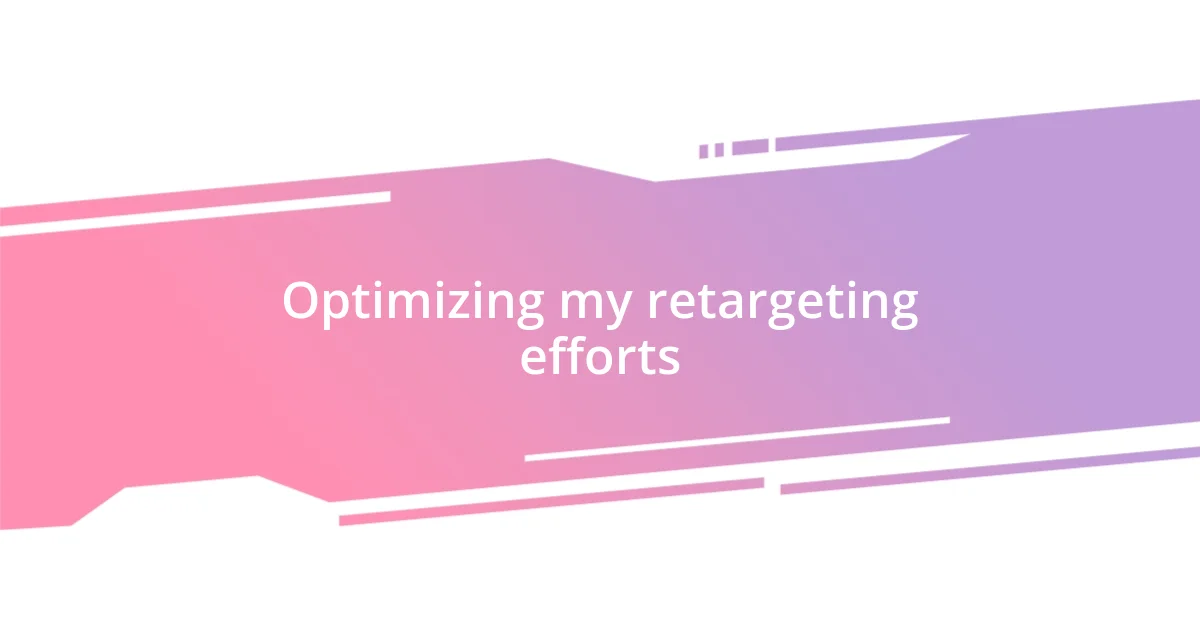Key takeaways:
- Retargeting effectively combines data-driven marketing with human behavior, creating emotional connections that can encourage consumer action.
- Key challenges in retargeting include audience segmentation, managing ad frequency to avoid fatigue, and accurately tracking conversions.
- Continuous performance analysis, flexible strategies, and the importance of creative storytelling in ads significantly enhance the effectiveness of retargeting campaigns.

Understanding retargeting strategies
Retargeting strategies are fascinating because they represent a unique blend of data-driven marketing and real human behavior. I recall launching a campaign where cookies helped us track users who visited our site but didn’t make a purchase. Suddenly, those individuals began seeing our ads everywhere—they were like old friends popping up, reminding them of what they had missed.
At its core, retargeting is about understanding consumer intent and interests. Have you ever wondered why those shoes you clicked on last week seem to follow you around the internet? It’s that sticky web of retargeting at play, trying to reel you back in. From my experience, this strategy can create a sense of familiarity and urgency, encouraging users to take action when they might have otherwise forgotten.
The emotional aspect of retargeting can’t be overlooked, either. When I see an ad for a product I once considered, it often ignites a little spark of desire or nostalgia. This is where I think the magic happens. It transforms a mere advertisement into a personal reminder, like a gentle nudge from a friend who knows exactly what you want. Isn’t it intriguing how effectively these strategies tap into our memories and emotions to drive decisions?

My initial challenges with retargeting
I vividly recall my early days diving into retargeting. Initially, I faced a steep learning curve—I had to grasp how to effectively segment audiences. It felt overwhelming to decide what messages would resonate best with various user groups. There was also a nagging worry about ad fatigue; I wanted to engage my audience, not annoy them with repetitive ads that pushed them away instead of drawing them in.
Another challenge was setting the right frequency for those ads. How often is too often? I remember a campaign where our ads were shown too frequently, and some users voiced their frustration. Balancing visibility and value in ads was a lesson learned the hard way, one that made me reassess my approach to customer touchpoints.
The complexity of tracking conversions was another hurdle. I found myself buried in analytics, trying to decipher data that felt like a labyrinth. There were times I’d question, “Am I really reaching the right audience?” This uncertainty planted a seed of doubt, making me reconsider my entire strategy. It’s those early struggles in understanding the intricate dance of retargeting that laid the groundwork for my eventual success.
| Challenge | Details |
|---|---|
| Audience Segmentation | Difficulty in targeting the right messages to different user groups. |
| Ad Frequency | Struggled with finding the balance between being visible and being annoying. |
| Tracking Conversions | Complex data analysis raised doubts about reaching the correct audience. |

Choosing the right retargeting platform
Choosing the right platform for retargeting can feel like navigating a maze. I remember sifting through options, pondering which one would deliver the best ROI. The variety of features—like audience segmentation and creative capabilities—made my head spin. It was essential to assess each platform based on specific business needs while keeping an eye on budget constraints.
Here are a few key considerations when choosing your retargeting platform:
– Targeting Capabilities: Look for platforms that offer in-depth segmentation options to tailor your audience precisely.
– Ad Formats Available: Different platforms provide varying creative formats. Choose one that aligns with your marketing strategy.
– Cost Structure: Some platforms work on a CPC (cost-per-click) model, while others are based on impressions. Understand what fits your budget best.
– Integration Ease: Ensure the platform easily integrates with your existing tools, like CRM systems or analytics services.
– Performance Tracking: Seek platforms with robust analytics features, allowing you to track and measure your campaign’s success effectively.
While I was making my platform choice, I found great value in platforms that offered strong support resources. Some even provided community forums where I could share insights and get tips from other marketers. That sense of camaraderie made a world of difference, transforming what could have been a solitary journey into a shared adventure. The right platform isn’t just about features; it’s about the support and community behind it that can help you learn and grow.

Crafting effective retargeting ads
Crafting effective retargeting ads is where the magic truly happens. I learned that personalization can make all the difference. One memorable campaign involved tailoring our ads based on users’ previous interactions. When I changed the messaging to reflect the products they’d viewed, the response was remarkable. It felt almost like having a conversation with potential customers instead of simply broadcasting a sales pitch.
Another crucial aspect is the visual appeal of your ads. I recall an instance when I decided to refresh our creatives after noticing a decline in engagement rates. A vibrant, eye-catching design coupled with a concise message transformed our ad performance overnight. It made me realize how much visuals can impact emotional responses and drive clicks.
Finally, I found testing and optimization to be indispensable in my retargeting journey. I recall A/B testing several ad variations, and it was fascinating to see which versions resonated more. It made me think, what if I hadn’t been open to experimenting? The freedom to learn from failures was liberating and helped shape more effective strategies over time, reinforcing the idea that continuous improvement is the backbone of effective retargeting.

Analyzing retargeting campaign performance
Analyzing the performance of retargeting campaigns is a crucial step that should never be overlooked. When I first delved into this phase, I was amazed at how deeply data could inform my decisions. For instance, I started by examining key metrics like click-through rates and conversion rates. It was eye-opening to see how small adjustments in my targeting could lead to significant shifts in these numbers. I often wondered, how could I have made quicker improvements if I’d paid more attention to this data from the start?
Beyond just numbers, I realized the importance of understanding user behavior. I used heatmaps to pinpoint where users clicked most frequently. I found it fascinating to observe that some ads performed well initially but gradually lost traction. This prompted me to ask myself why—was it the ad fatigue, or were the offerings no longer aligned with user interests? This deeper analysis allowed me to adapt my strategy and maintain engagement over time.
Continuous learning is key in this journey. I remember revisiting my campaigns after a few months had passed, armed with fresh insights from multiple data points. It became clear that retargeting isn’t a set-it-and-forget-it strategy. The more I analyzed performance trends, the more I understood my audience. This ongoing process not only helped me refine my campaigns but also deepened my connection with customers, making my marketing efforts feel more like a dialogue rather than a monologue.

Optimizing my retargeting efforts
Optimizing my retargeting efforts often felt like piecing together a puzzle, where every data point revealed something new. I once revisited an underperforming campaign and decided to segment my audience more granularly. To my surprise, tailoring ads to specific groups based on their previous engagement turned those numbers around dramatically. It made me realize that sometimes, a little more attention to detail can lead to substantial outcomes.
As I continued to fine-tune my strategies, I felt compelled to keep learning. One time, I attended a webinar that emphasized the importance of frequency capping—limiting how often the same user sees your ad. Implementing this strategy reduced ad fatigue and kept my brand fresh in the minds of users. I found myself wondering, was I unknowingly annoying my potential customers by showing them the same ad repeatedly?
The insights I gained from regular performance reviews stood out during one campaign, where I noticed a significant spike in engagement after a new season’s graphics were introduced. The fresh visuals not only caught eyes but also reignited interest in our products. This taught me an invaluable lesson: optimization isn’t just about metrics; it’s also about inspiring enthusiasm. Each tweak and adjustment I made felt like a conversation, where I invited users to engage with my brand rather than just seeing it as another advertisement.

Lessons learned from my journey
Reflecting back on my journey, one of the most profound lessons I learned was the significance of patience in retargeting. I remember launching a campaign and eagerly checking results within the first few hours, only to feel disheartened by lackluster performance. It hit me then that effective retargeting isn’t always about instant gratification; it requires time for the data to tell its story. Patience became my ally, allowing me to observe trends and make informed adjustments over time.
Another key takeaway was the power of creative storytelling in ads. I once decided to share a customer’s success story as part of a retargeting campaign. The response was overwhelming—it boosted engagement significantly! I wondered, why hadn’t I thought of this sooner? This taught me that connecting with audiences on a personal level can transform how they perceive a brand. Instead of just pushing products, we can share meaningful narratives that resonate and encourage action.
Lastly, I came to appreciate the importance of flexibility in my strategy. There was a moment when I had to pivot quickly due to changing market conditions, and at first, it felt daunting. However, adapting my approach helped me stay relevant and even uncovered new opportunities. It made me question, how often do we cling to outdated methods instead of embracing change? Flexibility not only enriched my understanding of retargeting but also taught me that success often lies in our ability to adjust and evolve.












